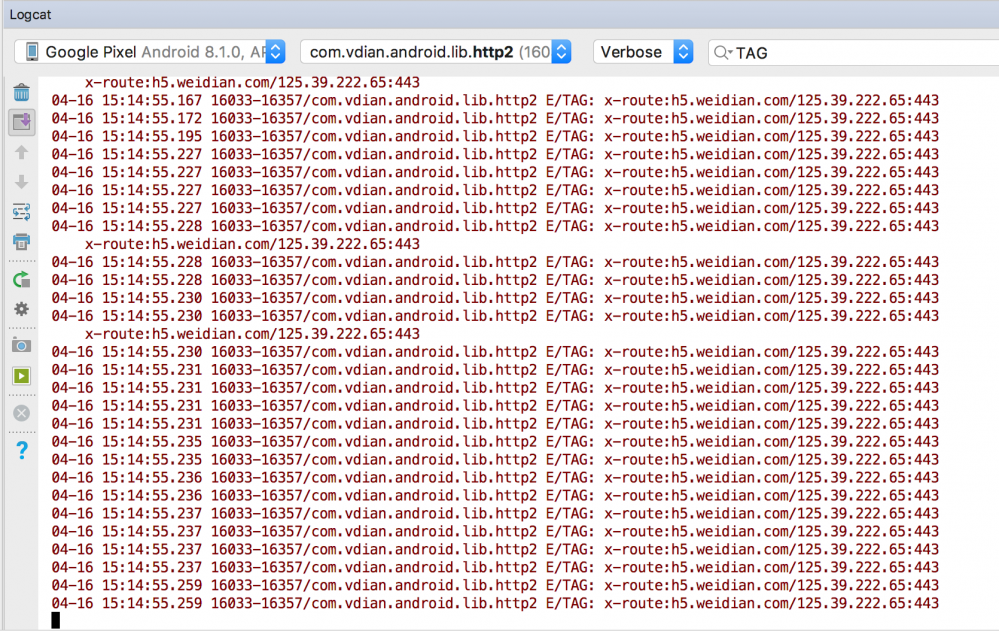当 OkHttp 遇上 Http 2.0
最近遇到了一个奇葩的问题,有个别用户反馈App上的菊花一直在转消失不掉,当时产生了几个猜想:
1、dns解析出问题了
2、服务端有问题
3、哪里超时了
4、哪里死循环了
一开始以为是偶然,结果短短一天内,有好几个用户反馈有这个问题,所以这绝对不是偶然,一定是有一个条件触发了这个bug。
由于我们自己调度了dns,所以一开始我们以为是httpdns的问题,但是通过简单的日志分析,发现其实并不是httpdns的问题,因为httpdns返回的解析结果和localdns的结果是完全一致的。所以基本排除了dns解析出问题了这个可能。
然后开始怀疑服务端有问题,但是通过发布系统查看发布记录,这几天并没有发过,唯一的一个改变就是运维切换了公网出口IP,但是通过httpdns日志已经排除了dns的问题,因此也不是这个问题。
在毫无头绪的时候,我们打了一个日志充足的包,让有问题的用户安装,结果很让人意外,竟然是网络库中的回调没有回来。于是去查看网络库的错误埋点日志,结果更让人意外, 该APP一天内有150w的timeout ,究竟是什么导致了这么大量的timeout呢?所以一开始直接把锅丢给了timeout,可是后来一想有点不对劲,哪里不对劲呢?
1、我们有两个App,该App一天有150w的timeout, 但是另一个App只有1w的timeout,这两个App有什么不同呢?不同的地方只有okhttp的版本,150w的timeout的App用的okhttp版本是3.4.1,另一个1w的timeout的App用的okhttp版本是3.9.1
2、timeout只会超时,超时时间到了还是会回调到error里,最终菊花会消失,但是现在的情况是回调没有进来。
于是排除了timeout的可能, 但timeout的量过大,这绝对也是个问题 ,至于为什么这么大,以及怎么解决,后面再细说。
由于用户频繁遇到了这个问题,考虑到可能是okhttp的bug,于是将okhttp升到3.9.1重新给用户一个新包,神奇的是用户没有再反馈这个问题了。所以基本断定是okhttp的bug了。
那么问题到底出在哪呢,通过对okhttp的issue的搜索,基本断定是3.4.1该版本的bug,通过查看changelog发现了猫腻
Version 3.4.2 2016-11-03 Fix: Recover gracefully when an HTTP/2connectionis shutdown. We had a bug where shutdown HTTP/2 connections were considered usable. This caused infinite loops when calls attempted to recover. Version 3.4.1 2016-07-10 Fix a major bug in encoding HTTP headers. In 3.4.0 and 3.4.0-RC1 OkHttp had an off-by-one bug in our HPACK encoder. This bug could have caused the wrong headers to be emitted after a sequence of HTTP/2 requests! Everyone who is using OkHttp 3.4.0 or 3.4.0-RC1 shouldupgradefor this bug fix.
官方发布过一个3.4.2的版本,修复okhttp在http2.0下使用了被关闭的连接,导致出现无限死循环。
如Changlog所说,这个问题是修复http2.0的,而我们已经全站https了,并且已经很久了,从App的反馈信息上来看,已经有95+%的请求是Http 2.0的了,基本符合这一条件。所以问题基本定位在了哪里出现了死循环了,最终导致回调没有回来。
问题找到了,那么怎么复现呢?这是个很头疼的问题,在完全抓瞎的情况下,我复现了一个礼拜,结果依旧没有复现出来。在一个偶然的情况下,突然复现出了一个死循环,但是完全是不知道怎么复现出来的,但是可以肯定,肯定是会出现死循环的。
在毫无头绪的情况下,把okhttp相关的issue都浏览了一遍,突然脑洞大开。既然是修复已关闭连接被错误使用,那么只要制造出一个已经建立连接然后将其意外关闭,但是不让okhttp知道它关闭了不就好了,那么怎么复现这个场景呢,其实很简单,如下:
1. 使用http2.0协议跟url建立连接,但是不关闭它 2. 断网 3. 联网 4. 再次向url建立连接,这时候会错误复用已关闭连接 5. 死循环出现
为了验证我的猜想,简单写了一个demo用于复现,我们先来看一段神奇的网络请求代码
final OkHttpClient httpClient = new OkHttpClient.Builder()
.followRedirects(false) //为了制造非200状态码,禁止302跳转
.protocols(Collections.unmodifiableList(Arrays.asList(Protocol.HTTP_1_1, Protocol.HTTP_2)))//启用http2.0协议
.addNetworkInterceptor(new Interceptor() {
@Override
public Responseintercept(Chain chain)throws IOException {
Request request = chain.request();
try {
Connection connection = chain.connection();
if (connection != null) {
Route route = connection.route();
//为了判断死循环,打印路由信息
Log.e("TAG", "x-route:" + route.socketAddress().toString() + "");
}
} catch (Throwable e) {
e.printStackTrace();
}
return chain.proceed(request);
}
})
.build();
public StringgetResult(final String url){
Request request = new Request.Builder()
.url(url)
.method("GET", null)
.build();
ResponseBody responseBody = null;
String result = null;
try {
Response response = httpClient.newCall(request).execute();
if (response.code() == 200) {
responseBody = response.body();
result = responseBody.string();
}
Log.e("TAG", "Successful-> protocol:" + response.protocol() + " code:" + response.code());
return result;
} catch (Exception e) {
e.printStackTrace();
Log.e("TAG", "Unsuccessful-> ", e);
} finally {
if (responseBody != null) {
try {
responseBody.close();
} catch (Exception e) {
e.printStackTrace();
}
}
}
return null;
}
简单看上面的getResult函数,其功能是向对应url发送一个get请求,并且禁止了302跳转,启用了Http2.0协议,在拦截器中打印了路由信息,在状态码为200的时候,返回了结果,完全没有毛病。 其实这个函数存在了一个致命的问题,刚好触发了okhttp的这个bug,那就是在http code!=200的时候,responseBody没有关闭 。
让我们一起来复现一下这个问题:
1、 首先开启网络
2、 发送一个http code返回非200的请求,导致流没有被关闭
new Thread(new Runnable() {
@Override
public void run() {
//会出现http code 302,导致连接未关闭
getResult("https://h5.weidian.com/");
}
}).start();
3、 关闭网络,如进入飞行模式
4、 开启网络,如退出飞行模式
5、 发送一个http code 返回200的请求
new Thread(new Runnable() {
@Override
public void run() {
//会出现http code 200
getResult("https://h5.weidian.com/m/weidian-buyer/error/index.html");
}
}).start();
6、 开始上演死循环悲剧,如图所示

很完美的复现出了这个死循环问题,为什么会产生死循环呢?通过查看okhttp的代码发现,okhttp代码有太多的while(true)了,一不小心就break不了陷入死循环。比如在拦截器里随便抛一个IOException,随随便便死循环,3.3.0之后的版本全部中招,包括最新版3.10.0。
//仅供演示,请勿模仿
//.addNetworkInterceptor(new Interceptor() {
// @Override
// public Response intercept(Chain chain) throws IOException {
// throw new IOException("mock io exception");
// }
//})
在RetryAndFollowUpInterceptor中有这么一段代码
public final class RetryAndFollowUpInterceptorimplements Interceptor{
@Override public Responseintercept(Chain chain)throws IOException {
//....省略n行代码
while (true) {
//....省略n行代码
Response response = null;
boolean releaseConnection = true;
try {
//复用已关闭连接,出现IOException("shutdown")
response = ((RealInterceptorChain) chain).proceed(request, streamAllocation, null, null);
releaseConnection = false;
} catch (RouteException e) {
// The attempt to connect via a route failed. The request will not have been sent.
if (!recover(e.getLastConnectException(), true, request)) throw e.getLastConnectException();
releaseConnection = false;
continue;
} catch (IOException e) {
//异常被捕获,尝试恢复
// An attempt to communicate with a server failed. The request may have been sent.
if (!recover(e, false, request)) throw e;
//如果不能恢复,抛异常,如果能恢复,进行重试
//很不幸该场景下,这里一直返回了true
releaseConnection = false;
continue;
} finally {
// We're throwing an unchecked exception. Release any resources.
if (releaseConnection) {
streamAllocation.streamFailed(null);
streamAllocation.release();
}
}
//省略n行代码
}
}
private boolean recover(IOException e,boolean routeException, Request userRequest){
streamAllocation.streamFailed(e);
// The application layer has forbidden retries.
if (!client.retryOnConnectionFailure()) return false;
// We can't send the request body again.
if (!routeException && userRequest.body() instanceof UnrepeatableRequestBody) return false;
// This exception is fatal.
if (!isRecoverable(e, routeException)) return false;
// No more routes to attempt.
if (!streamAllocation.hasMoreRoutes()) return false;
// For failure recovery, use the same route selector with a new connection.
return true;
}
private boolean isRecoverable(IOException e,boolean routeException){
// If there was a protocol problem, don't recover.
if (e instanceof ProtocolException) {
return false;
}
// If there was an interruption don't recover, but if there was a timeout connecting to a route
// we should try the next route (if there is one).
if (e instanceof InterruptedIOException) {
return e instanceof SocketTimeoutException && routeException;
}
// Look for known client-side or negotiation errors that are unlikely to be fixed by trying
// again with a different route.
if (e instanceof SSLHandshakeException) {
// If the problem was a CertificateException from the X509TrustManager,
// do not retry.
if (e.getCause() instanceof CertificateException) {
return false;
}
}
if (e instanceof SSLPeerUnverifiedException) {
// e.g. a certificate pinning error.
return false;
}
// An example of one we might want to retry with a different route is a problem connecting to a
// proxy and would manifest as a standard IOException. Unless it is one we know we should not
// retry, we return true and try a new route.
return true;
}
}
妈的最外层一个while(true),在执行response = ((RealInterceptorChain) chain).proceed(request, streamAllocation, null, null);时发生了IOException(“shutdown”),被捕获,然后调用recover函数尝试恢复连接,但是很不幸的是recover返回了true,而此时连接却已经被意外关闭的(断网再联网),也就是后续将复用一个已关闭的连接,悲剧的导致了无限死循环。不看不知道,一看吓一跳,除了这一处while(true),okhttp其他地方还有很多while(true),这要是一个不小心,就掉坑里了。
问题找到了吗?确切的说是找到了一个问题,还有很多问题没有找到,这里只是找到了一个复现场景,但是不能保证用户的复现路径是怎么样的,但至少已经验证了猜想。
那么要怎么修复这个问题呢?其实非常简单。
1、这个问题只有在Http 2.0下有问题,因为Http 2.0使用多路复用,一个域名不会建立多个connection,所有请求进行多路复用使用同一个connection,因此解决这个无限死循环的一个方法就是禁用Http 2.0,但显然是无法接受的,所以不予考虑,不过也给出OkHttp禁用http 2.0的方式
OkHttpClient httpClient = new OkHttpClient.Builder() .protocols(Collections.unmodifiableList(Arrays.asList(Protocol.HTTP_1_1)))//启用http1.1,禁用http 2.0 .build();
2、okhttp在连接失败时会进行重试,从而导致了这个无限重试的悲剧,因此可以关闭失败重试的功能,但是这会降低请求成功率,也是不能接受的,所以也不予考虑,不过也给出对应代码。
OkHttpClient httpClient = new OkHttpClient.Builder() .retryOnConnectionFailure(false) .build()
3、经过测试,发现以上的无限死循环问题在okhttp [3.3.0,3.5.0]全部中招,因此可以使用3.2.0版本或者使用最新的3.10.0版本,可以从一定程度上杜绝这个问题,但是也不能保证一定不会再出现死循环,也许还有其他触发条件呢,谁也不能保证。所以升级okhttp这个成本比较低,可以考虑。
4、既然http code!=200时流未关闭的情况下,连接意外中断触发了这个死循环,那么避免问题出现的简单有效的途就是我管你http code为多少,统统关闭就好了,对应修改后的getResult函数如下:
public String getResult(final String url) {
Request request = new Request.Builder()
.url(url)
.method("GET", null)
.build();
Response response = null;
String result = null;
try {
response = httpClient.newCall(request).execute();
if (response.code() == 200) {
ResponseBody responseBody = response.body();
result = responseBody.string();
}
Log.e("TAG", "Successful-> protocol:" + response.protocol() + " code:" + response.code());
return result;
} catch (Exception e) {
e.printStackTrace();
Log.e("TAG", "Unsuccessful-> ", e);
} finally {
if (response != null) {
try {
response.close();
} catch (Exception e) {
e.printStackTrace();
}
}
}
return null;
}
bug修完了,还剩下一个问题待解决,150w的timeout是从哪里来的?这个问题我没办法在现有手头上的真机复现,但是我在genymotion模拟器上复现了出来,所有我猜想必然还会存在一个机型复现出这个问题,只是目前手头上的机型没有这个问题,而这个问题的前提条件也必须是Http 2.0,复现方式也是非常简单:
1、联网
2、发送一个Http2.0请求建立连接,使用完后关闭连接(Http 2.0下会发送一个帧)
3、断网
4、联网
5、发送Http2.0请求,超时时间到了后,会触发timeout
6、之后发送n个请求,都不会成功,直到连接复用池中已关闭的连接被清理掉(默认5分钟,5分钟后才会有成功的请求产生)
这个问题的解决方法也比较简单:
1、升级okhttp到最新3.10.0的版本,高版本对复用池中的连接做了严格的ping pong的验证,一定程度上可以保证被使用的连接是没有被关闭的,即使被关闭,也可以通过重试重新建立一个新的连接。
2、捕捉SocketTimeoutException异常,清理连接池中无用连接,这个代码中稍微处理一下就好了,对应的代码如下:
okhttp3.Response response = null;
try {
response = call.execute();
} catch (SocketTimeoutException e) {
e.printStackTrace();
try {
okhttpclient.connectionPool().evictAll();
} catch (Exception e1) {
e1.printStackTrace();
}
throw e;
} catch (IOException e) {
throw e;
} finally {
}
除了这个timeout异常之外,还有一个异常也特别多,就是UnknownHostException,这个问题也可以用timeout的复现步骤复现出来,因此这个异常发生时,也最好清理一下连接池中的无用连接。
java.net.UnknownHostException: Unable to resolve host "your.domain.com": Noaddressassociated with hostname
优化后的代码如下:
okhttp3.Response response = null;
try {
response = call.execute();
} catch (SocketTimeoutException e) {
e.printStackTrace();
try {
okhttpclient.connectionPool().evictAll();
} catch (Exception e1) {
e1.printStackTrace();
}
throw e;
} catch (UnknownHostException e) {
e.printStackTrace();
try {
okhttpclient.connectionPool().evictAll();
} catch (Exception e1) {
e1.printStackTrace();
}
throw e;
} catch (IOException e) {
throw e;
} finally {
}
排查了一个礼拜,最终总算把问题给解决了,也算是一身轻松了。











![[HBLOG]公众号](https://www.liuhaihua.cn/img/qrcode_gzh.jpg)

